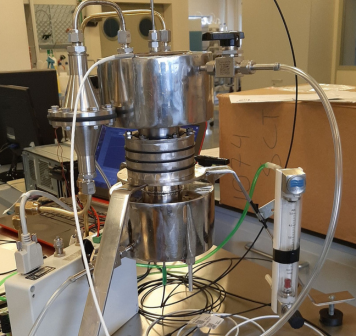2024 Adaptable permeameter device for measuring membrane permeability
The University has developed an adaptable and versatile permeameter device designed to measure the permeability of biological and industrial membranes of different sizes and degrees of permeability.
TRL 7: Device validated in relevant operating environments
Utility Model Application No. U202430857

This device makes it possible to measure the permeability to the main gases involved in respiration (O₂ and CO₂) and to water vapour (H₂Og) in a single measurement cycle.
Technology description
The main innovation of this device lies in its modular design, which allows customised configuration according to experimental needs, by interchanging its fundamental elements. This device makes it possible to measure the permeability to the main gases involved in respiration (O₂ and CO₂) and to water vapour (H₂Og) in a single measurement cycle. In addition, it provides three different user-selectable measurement techniques:
- Dynamic accumulation concentration analysis of the permeant gas.
- Carrier gas concentration analysis.
- Hybrid mode, which combines the two previous techniques.
The Problem
Currently available devices for measuring membrane permeability are mainly designed for large industrial membranes and are often specific to a single gas.
This limitation leaves unmet research needs for biological membranes, which are often smaller and more complex. In addition, current devices lack the flexibility to adapt to different sizes and permeability grades, which restricts their application in critical areas such as post-harvest preservation or the study of physiological processes in plant tissues.
Potential Advantages
- Experimental flexibility: its modular design allows the measurement of membranes of different sizes and permeability grades, making it unique in the market.
- Accurate and complete measurements: it allows the evaluation of permeability to multiple gases (O₂, CO₂, H₂Og) in the same cycle, something not available in other devices.
- Post-harvest optimization: facilitates the development of advanced techniques such as modified atmosphere packaging (MAP) to extend the shelf life of fruit and vegetables.
- Low cost and sustainability: the possibility of using commercial sensors and controllers significantly reduces operational and maintenance costs.
- Transversal applications: ranging from plant physiology studies to polymer research and packaging technologies.
Objective of the collaboration
The permeameter device represents a key innovation in the measurement of the permeability of biological and industrial membranes, opening up a wide range of opportunities for collaboration and technology transfer to third parties interested in its commercialisation and full exploitation.
The objective is to transfer this technology to companies or institutions capable of developing, commercialising and applying it in various strategic areas, maximising its impact in sectors such as research, agro-industry and the polymer industry.
In collaboration with:

